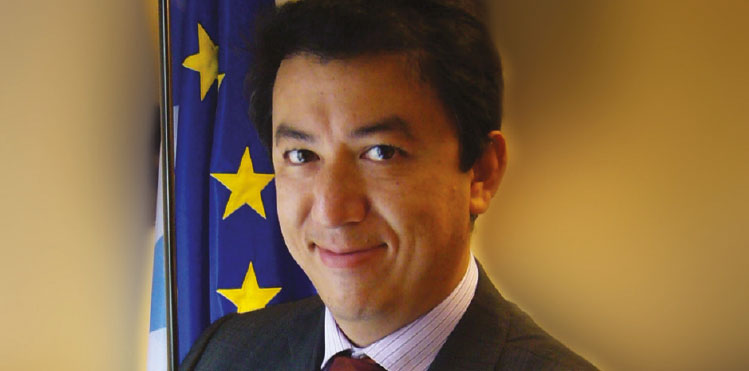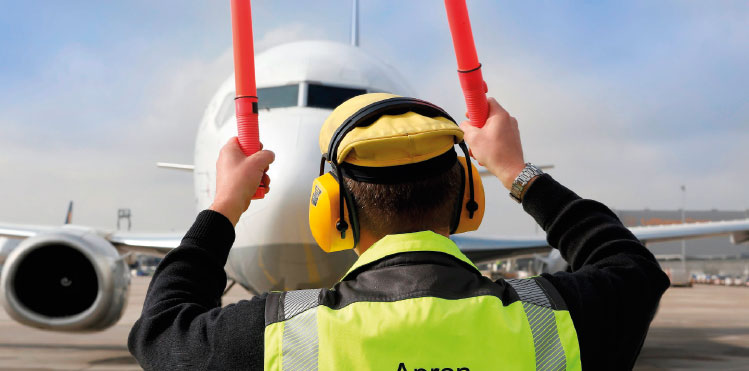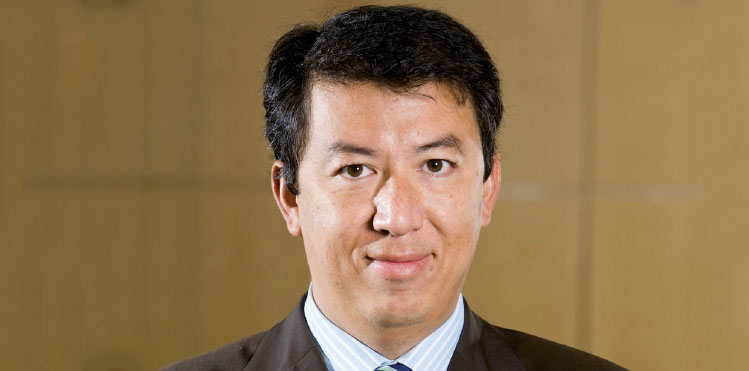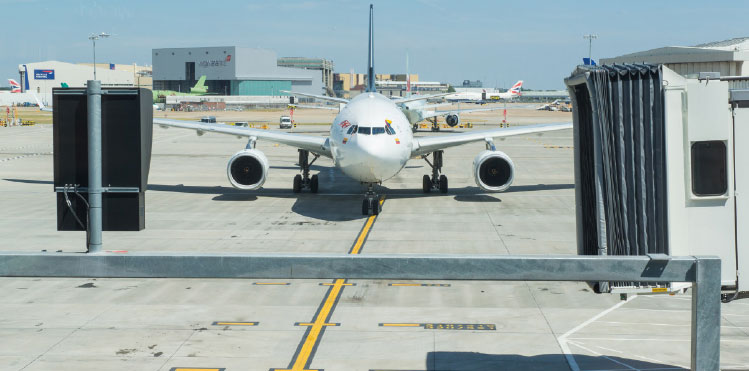
Patrick Ky, Executive Director, European Aviation Safety Agency: “My mandate is to protect the European citizens – the citizen at large – and EASA needs to work closely with the service providers to the citizens – the airlines, airports, and national authorities. Only together can we make sure we are delivering the highest level of safety to our passengers.”
The European Aviation Safety Agency (EASA) is embracing its new, wider scope, with an inclusive approach that reaches out to all stakeholders. Executive Director Patrick Ky took some time out of the recent EASA-FAA International Aviation Safety Conference for a walk in the Botanical Garden of Brussels, to explain the renewed EASA vision to Amy Hanna.
For every stakeholder in the air transport journey, the passenger is at the centre of our industry. It is the ambition of each airport, airline, Civil Aviation Authority and regulatory body to deliver an exceptional experience from departure to arrival – to strive for the satisfaction, the smooth and streamlined processing and, most crucially, the safety of every traveller that takes off and touches down at our gateways.
For Patrick Ky, ensuring the safety and security of every traveller that passes through the European air transport system has become a calling. It is the concern that keeps him awake at night and a crusade to which he has dedicated his professional and personal pursuit. The Executive Director of the European Aviation Safety Agency (EASA) is working to bring about real change within the infrastructure of the industry, to ensure that European aviation is the safest that it can be.
Ky became EASA’s Executive Director in September 2013 and since his appointment has faced some onerous challenges. He has stepped into the role at a time when – despite the fact that worldwide aviation safety is at its highest, with the rate of accidents compared to the number of flights lower than ever – the passenger perception of flying is not one of great certainty, with high profile tragedies of recent months bringing the safety of travelling by plane into public question. Aviation, meanwhile, is in the midst of great change, and from evolving technologies and advancing standards have sprung forth a fresh set of obstacles and opportunities, which industry stakeholders must now consider how to control.
Ky’s experience of the air transport business has spanned an entire career. Following senior positions in the French Civil Aviation Authority and EUROCONTROL, he headed the SESAR programme – Europe’s ambitious Air Traffic Management modernisation project, there gaining knowledge of the needs of industry that has enabled him to pioneer EASA’s progression. His primary ambition in his present role has been to bring together EASA with air transport stakeholders and Civil Aviation Authorities and, importantly, dispel the impression that EASA is “a powerful but rigid administrative organisation”, building relationships free of the tensions and resistance that once stood between the organisation and the industry. “We have started to simplify the way in which we regulate the industry,” Ky said. “It’s going to take time, but I think we are making very good progress. In EASA we are a people who are passionate about aviation, so for us to be perceived as bureaucrats and administrative tyrants – this is not what we are at all. My main objective was to change this image of EASA as this big administrative organisation, to be closer to our partners and ensure that we have the highest levels of safety for aviation in Europe.”
It is Ky’s vision that the stakeholders in the passenger journey will work together to overcome the challenges that the developing industry will bring, to enhance the level of service and safety, to come as close as possible to eliminating devastating incidents like those of the recent past, and to restore travellers’ faith in air travel. “We need to work to make sure that we do not have the catastrophic accidents that we have seen in recent months. It may never be possible to guarantee that there will be no accidents, but we should certainly be aiming for this,” Ky furthered. “And that means that for each incident that happens, no matter how significant, we have a thorough analysis of what happened. Is it due to the aircraft? Is it due to the pilot? Is it due to the weather? Is it due to the airport? Then, every time we try to correct what went wrong. Every time.”
What airports need to know
Ky joined EASA at an important time, as the Agency was finalising the new Aerodrome Regulations which will see Europe’s airports transition from their current licences to comply with the EASA Certificate in new legislation that reflects the state of the modern industry, and the need for a universal safety management system. The introduction of these directives marked the first time that EASA has regulated in the airport domain. “At the end of the day, what matters in aviation is the passenger,” Ky established. “And airports, like airlines, are really the ones who, for passengers, are the face of aviation. It’s extremely important that we work together with airlines and airports in order to bring passengers the level and quality of service that they are expecting from aviation.”
The introduction of the Aerodrome Regulations was initially met with some opposition from a number of Europe’s gateways – much as EASA’s earlier activities faced resistance from CAAs – and most frequently in reaction to the anticipated need for investment to meet the regulation criteria. “But actually,” Ky explained, “in our regulations we are simply enforcing the global ICAO standards, and those airports were just not in compliance with those, which I don’t think is right.”
“At the end of the day, those airports were not doing what they should be – and the Civil Aviation Authorities have not done their work in enforcing that. And we understand this of course – it’s because of local pressures. If an airport in a small city has to make an investment this has an impact on the economy of the city itself, and therefore there is pressure in parliament and so on and so forth… But our problem is the safety of passengers.”
In the time since the regulations’ announcement, support from the airport industry has strengthened, and Europe’s gateways are largely now acting in advocacy of the region-wide ruling. “We are talking about levelling the playing field,” Ky added. “We are not imposing anything just for the pleasure of imposing it. These are ICAO standards. It’s the same rule for everybody, and we think that makes sense.”
Ky change

“Everything is connected,” Ky said. “You cannot work with an airport without also talking about Air Traffic Management. And when you talk about Air Traffic Management it has an impact on airline operations, and when you talk about airlines operations you talk about the operator of the aircraft. It just makes sense to have one authority looking at all the different domains.”
“When we talk about Europe regulating airports we know that there are very strong reactions against it – those who say that an airport is a local organisation, why should it be governed by European rules? But aviation is international,” Ky stated. “In Europe 65-70% of flights cross at least one boundary, which means that to have some airports with specific rules and others with different rules just doesn’t make any sense – that is not a level playing field.” Ky aspires to see every airport in Europe, and beyond, work in harmony with the dozens of gateways to which it is directly and indirectly connected, so that together they may operate in the safest possible way. In order to achieve this, despite the smoothening friction between EASA and the authorities of its Member States, the organisation remains cautious about not being too prescriptive in its rulings, creating a flexible environment in which Civil Aviation Authorities can interpret regulations in a manner that best enables local implementation of the rules.
“Because airports are so inherently ‘local’, there are things that we don’t know – and that we don’t really need to know – at a European level, but we did need to build in flexibility to take into account those very local constraints,” Ky stated. “Now, however, while we are starting to see some countries really make the best of those flexibility clauses, other countries are overplaying their role and are imposing on the airports more constraints than those which we had thought about.” Among the new, and often unprecedented challenges that EASA has faced on entering this new domain is creating a standard that can be implemented by each of its 32 Member States (the 28 EU nations, as well as Iceland, Liechtenstein, Norway and Switzerland) – 32 very different cultures and varied legal climates which EASA must co-ordinate in harmony. “Flexibility for a German civil servant for example might mean something completely different to flexibility for an Italian civil servant, and so I think it’s quite normal that we are, in this very new relationship, learning by doing,” Ky established. “And in all the places where there are differences in the interpretation of the implementation of the rules, all this will harmonise itself, and a balance will be found eventually. That is the nature of the game.”
One vision

It is Ky’s vision that the stakeholders in the passenger journey will work together to overcome the challenges that the developing industry will bring, to enhance the level of service and safety, to come as close as possible to eliminating devastating incidents like those of the recent past, and to restore travellers’ faith in air travel.
Ky explained that, where airports are concerned, EASA is at the start of a “long and important story”, over the course of which it will work to build its interest in an increasing number of aspects of their operation. “Everything is connected,” he said. “You cannot work with an airport without also talking about Air Traffic Management. And when you talk about Air Traffic Management it has an impact on airline operations, and when you talk about airlines operations you talk about the operator of the aircraft. It just makes sense to have one authority looking at all the different domains.”
EASA is reaching out to the industry, and now works in close coordination with ACI EUROPE, the only organisation with which EASA has so solid a partnership. In 2013, ACI EUROPE and EASA held a series of joint workshops as a forum to discuss the Aerodrome Rulemaking Process, and EASA has continued to engage with airports in the ongoing development of its aviation strategy. In the first quarter of this year EASA published Vision 2020, its proposals for the future of the aviation regulatory system. These proposals, presented as an ‘EASA Opinion’, are the outcome of a comprehensive consultation with stakeholders which started in September 2014. “The first guiding principle of this Opinion is that EASA cannot work alone. EASA, its Member States and their national authorities are part of the same system – and we really need to have that as the philosophy of the system,” Ky enthused. “That means that when you have a fault in one of the national authorities you need to find a mechanism to take over. To make sure that as a system, the quality of the service is the same.”
Among the principles outlined in the Opinion is the proposal that when a national authority has a lack of resources or expertise, they should be able to delegate some of their oversight functions to other authorities or to EASA, in order to make sure that no safety risks are overlooked. “I think this is the most important notion in this Opinion,” Ky said, “because when you look at what is needed in order to do this it is very complex. We are talking about a national authority for some reason may not be able to fulfil its tasks, and if that is the case then who’s going to do it? Is it EASA or is it another national authority? Who is going to pay for it? All those questions. And to answer them we need one system, in which we can harmonise the way in which it is operated.”
The Opinion also proposes that, on a voluntary basis, Member States can decide that their State aircraft (excluding military) can be covered by EASA and, importantly, proposals also include the extension of the Agency’s scope of intervention in new domains, such as airport ground handling. Having some input into this area of airport functionality would enable EASA to react to the multitude of minor accidents that impose upon the smooth and safe operation that airports aspire to on a daily basis. A small collision between aircraft and truck on a taxiway, damage to a boarding bridge, or an overrun on the runway all have huge economic impact and a detrimental effect on the service that is offered to passengers, and can, Ky explained, be mitigated by the inclusion of airport ground handling within the scope of EASA.

The European Commission is expected to draft a new Basic Regulation for EASA as part of its forthcoming aviation package. Set for completion in November of this year, the new aviation strategy will take into consideration a great number of factors, such as the competitiveness of the European aviation industry and the importance of safety in aviation, and including the recently published EASA Opinion.
Airport security would also become a priority for EASA under the Opinion. “EASA’s involvement in ground handling is really a technical adaptation – it is a logical step. But in security I think our participation in this area is really necessary. All of the Civil Aviation Authorities in Europe have their individual security landscape – we are overseeing national authorities, and this is one part of that that we don’t look at at all? It just doesn’t make sense,” Ky said. “We are seeing more and more that safety is never completely isolated from security, and security is never completely isolated from safety. So we need to bring in the link between the two – and I believe personally that EASA is the body to do that.”
On the horizon

EASA is reaching out to the industry, and now works in close coordination with ACI EUROPE, the only organisation with which EASA has so solid a partnership. In 2013, ACI EUROPE and EASA held a series of joint workshops as a forum to discuss the Aerodrome Rulemaking Process, and EASA has continued to engage with airports in the ongoing development of its aviation strategy.
The European Commission is expected to draft a new Basic Regulation for EASA as part of its forthcoming aviation package. Set for completion in November of this year, the new aviation strategy will take into consideration a great number of factors, such as the competitiveness of the European aviation industry and the importance of safety in aviation, and including the EASA Opinion. At the time of the Opinion’s publishing, Ky stressed its importance as a tool for preparedness as our industry develops into the future. “EASA – that means the Agency and its sister national authorities,” he said, “needs to be prepared for the challenges ahead. With these changes, we will be more proportional, flexible and proactive to increase the level of safety in European aviation.”
These challenges to the industry, he explained, are changing all the time, and for national authorities to keep up with the pace at which innovation is influencing its operation it is becoming increasingly difficult. The proliferation of new technologies for example requires the hiring of appropriate experts; next generation aircraft demands the greater knowledge of pilots; the prevalence of cyber security presents new threats; new entrants to the market need new certification; and until recently unprecedented developments such as civilian drones must also be surmounted. “These are all things on which we need to pool our resources and, crucially, we need to build the mechanism, which is not an easy thing to do, but it is important in enabling us to overcome the challenges ahead,” Ky explained. “My mandate is to protect the European citizens – the citizen at large – and EASA needs to work closely with the service providers to the citizens – the airlines, airports, and national authorities. Only together can we make sure we are delivering the highest level of safety to our passengers.”







